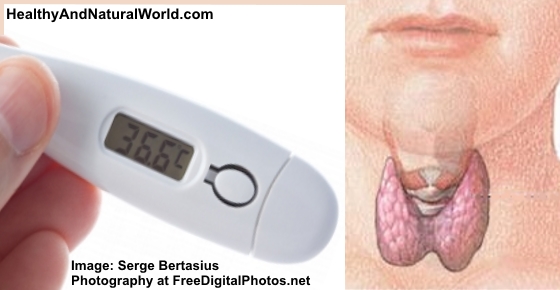How to Test Your Thyroid With a Thermometer

The thyroid is a tiny, butterfly-shaped gland which plays an important role in your well-being and health. It is located in your neck, just above your collarbone and it’s one of your endocrine glands, which make hormones that control many activities in your body. The thyroid makes sure the body’s metabolism, temperature, vitality and development are in order.
Read on to find out how to check the condition of your thyroid using a thermometer.
The Functions of the Thyroid
The thyroid gland takes iodine from the food and converts it into thyroid hormones T3 and T4. Hence, in geographic areas where iodine supply is scarce (and is not supplemented), we can often see more people with thyroid problems.
- Triiodothyronine (T3) and thyroxine (T4) are two of the hormones the thyroid secretes and they control the metabolism.
- The other thyroid hormone is calcitonin, which regulates calcium levels in the blood and bones.
- The thyroid makes sure we have sufficient energy – the first symptom telling you that something is wrong is often tiredness.
- The thyroid is responsible for growth and development. If children don’t get enough thyroid hormones when they’re growing up, this can result in brain abnormalities and lower IQ.
Normally, the thyroid is not visible or palpable. When its function is disturbed, the gland can become abnormally enlarged – this is known as goiter.
According to the American Thyroid Association more than 12% of the U.S. population will develop a thyroid condition during their lifetime, and these are many millions of people.
Hypothyroidism
Hypothyroidism is a condition where the thyroid gland is under-active and doesn’t produce enough of its hormones.
A person can already be born with a gland deficiency, or the condition can develop later due to autoimmune causes (such as Hashimoto’s thyroiditis), radiation therapy and certain medications, or too little iodine in the diet.
Limited production of thyroid hormones can limit the full function of almost every part of your body.
Richard L.Shames,MD, and Karilee Shames RN, Phd authors of the Thyroid Mind Power estimate that 50 million Americans may have low level of thyroid hormones.
The main symptoms of hypothyroidism include:
- High TSH levels
- Unexplained weight gain
- Constipation
- Depression
- Fatigue
- Pale dry skin
- Baldness
- Increased sensitivity to cold
Doctors diagnose hyperthyroidism by testing TSH (thyroid stimulating hormone) levels in addition to the blood test results of T4 and T3 levels. Low TSH levels usually mean that you suffer from hypothyroidism and your thyroid is producing too much T3 and T4 thyroid hormones.
For a detailed list of symptoms, read my post about the top 13 signs you have a thyroid disorder.
Why it’s Hard to Detect Hypothyroidism
According to Jacob Teitelbaum MD and Bill Gotlib CHC authors of the Real Cause Real Cure, most doctors don’t know about research showing that the TSH test (a test for evaluating thyroid function and/or symptoms of a thyroid disorder) is unreliable.
Dr. Teitelbaum adds that over the decades these tests have been continually updated with ever expanding definitions of who is and isn’t hypothyroid. He says that there is no reason to believe that the current test effectively detects every case of hypothyroidism.
In 2002 the American Association of Clinical endocrinologists (AACE) revised the normal range for TSH test (0.5 to 5.0) stating that anyone with a TSH of over 3.0 is hypothyroid. This means that approximately 13 million Americans with ranges from 3.1 to 5.0 had not been treated for hypothyroidism because their lab results regarded as normal.
The American Association of Clinical Endocrinologists estimated that the new guidelines actually double the number of people who have abnormal thyroid function.
The Thyroid Armpit Test
This test is recommended by Dr. Teitelbaum for anyone who suffers from several of the symptoms of hypothyroidism.
Because the thyroid gland reflects the body’s metabolic rate and heat is generated during metabolism, your body temperature can give clues regarding the function of the thyroid gland.
If you suspect that you suffer from hypothyroidism then a self test using a thermometer can provide more evidence.
How to Test Your Thyroid with a Thermometer
In order to do this test you will need to have a basal thermometer (like this one). A basal thermometer is a very sensitive thermometer that measures temperature changes more closely than a regular thermometer. You can purchase a basal thermometer at almost any drugstore or online.
- Keep a basal thermometer beside your bed.
- Check your armpit (axilla) temperature for several days in the morning when you wake up. Before getting out of bed put the thermometer in your armpit.
- Lie quietly for 10 minutes
According to Dr. Teitelbaum, if your temperature is under 97.4 degrees Fahrenheit (36.33 degrees Celsius) on two repeat measurements, you and your doctor should consider treatment with thyroid hormone.
In his own practice, Dr. Teitelbaum asks patients with thyroid symptoms to take oral temperature between 11:00 a.m. and 7:00 p.m. on two different days. If it’s regularly below 98.1 degrees Fahrenheit (36.72 degrees Celsius) he treats the person for hypothyroidism.
For women, who are still menstruating, the test should be done on the second, third, and fourth days of the menstrual cycle. The reason is because a considerable temperature rise may occur around the time of ovulation and give incorrect results. Post-menopausal women or men can conduct the tests any days of the month.
The test is not to be used as a replacement for a proper medical assessment. Instead it can help you determine whether you may have a thyroid imbalance and a low functioning thyroid gland in particular.
Read more related articles:
